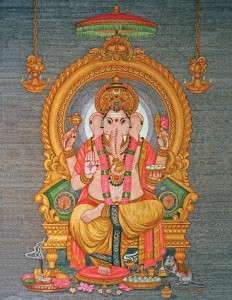Twitter Update: A shot from the Ganesha Chaturthi puja happening r…
A shot from the Ganesha Chaturthi puja happening right now http://t.co/1GhovBpG9t

Happy Ganesha Chaturthi

Lord Siva, the Almighty Power, created Heaven and Earth and the God Lord Ganesa to oversee the intricate karmas and dharmas within the heavens and all the earths. Lord Ganesa was created as a governor and interplanetary, intergalactic Lord. His knowledge is infinite, His judgment is just. It is none other than Lord Ganesa and His mighty band of ganas who gently help souls out of the Naraka abyss and adjust them into higher consciousness after due penance has been paid, guiding them on the right path toward dharmic destiny. He is intricate of mind, loving pomp, delighting in all things sweet and enjoying adulation. Lord Siva proclaimed that this son be worshiped first, even before Himself. Verily, He is the Lord of Karma. All Mahadevas, minor Gods, devas and sentient beings must worship Ganesa before any responsible act could hope to be successful. Those who do not are subject to their own barriers. Yea, worship of Him sets the pattern of one's destiny. The Tirumantiram says, "Five-armed is He, elephant-faced with tusks protruding, crescent-shaped, son of Siva, wisdom's flower, in heart enshrined, His feet I praise." Aum Namah Sivaya.
Gurudeva Padapuja

Today we celebrate Gurudeva as we invoke his inner blessings and observe the love with which he changed all of our lives. Jai Gurudeva!
From Living with Siva:
"Love is inclusive, not exclusive, on the spiritual path...
Hindu temples sustain Hinduism around the world. Scriptures keep us always reminded of the path we are on and the path we are supposed to be on, but only from the satguru can you get the spirit, the Sakti, the sustaining spirit, to make it all come to life in you, to make the temple meaningful and to complement the scriptures with your own sight, your own third-eye sight. Otherwise, it's just words. Nathas are not on the path of words. The Rishi wandered down from the Himalayas to Bangalore. What did he say? Nobody knows. Whom did he talk to? Nobody knows. Did he influence crowds of people? Perhaps, but he only had to influence one individual, Kadaitswami, to speak out to the world. Kadaitswami caught the spirit of the Rishi, who had caught the spirit of the previous Rishi, the previous Rishi and all the ones that preceded him. It is that spirit of sampradaya that makes the traditional teachings meaningful, that gives you the power to discriminate between what is real within those teachings and what is superfluous or just plain nonsense, that gives you the power to blend Siddhanta with Vedanta, Vedas with Agamas. The irreversible spirit of the guru carries through all of the sishyas. It is basically the only gift a guru can give--that sustaining spirit. He doesn't have to give knowledge, because that has already been written down. He doesn't have to build temples, because there are more than enough temples for everyone. The rare and precious gift that he can convey is the inner spirit of his religious heritage. That is his unique gift to the world. Nathas do not follow the way of words.
Twitter Update: Happy Ganesha Chaturthi http://t.co/YFQCNsbrRd

Siva's Moon Over Waialeale

Last night, just after sunset, a beautiful moon could be seen over the sacred Mount Waialeale, which was surprisingly clear for this time of evening.
Water is the body of the vital breath and that moon yonder is its luminous organ. And as far as the vital breath extends, so far extends water and so far extends the moon. These are all equal, all infinite. He who meditates upon them as finite wins a finite world, but he who meditates upon them as infinite wins an infinite world.
Ajur Veda, Brihadaranyaka Upanishad I, V-Manifestations of Prajapati, 13
Tour Day

Another group of visitors has a chance to see Iriavan Temple and the monastery's gardens. Here everyone poses in front of Dakshinamurti for a group photo.
September Homa

Today the monks held a morning homa, invoking the inner worlds for blessings and guidance, while worshiping Siva in the sacred fire. Afterward Satguru Bodhinatha gave a talk about the power of any form of worship, being largely dependent upon the worshiper's devotion. He read from today's Lesson from Merging with Siva:
Unconditional Surrender
What do we mean by internalizing worship? In external worship we are trying to see God and communicate with God with our two eyes and our physical nerve system. We enjoy His darshan and feel His shakti. In deep meditation, the external worship is deliberately internalized, and we are trying to see God with our third eye and feel God's all-pervasiveness through our psychic nerve system. Externalizing bhakti is really much easier than internalizing it. But once the externalized bhakti is perfected, it will be easy and natural to internalize bhakti right along. When this is accomplished, the most rigorous hurdles and time-consuming practices of yoga, which often lead the person onto anava marga, will have been side-stepped.
To internalize worship, after the puja is over, sit before the Deity and draw into yourself all the pranas you feel around your body. Then draw those energies up the spine into the head. This is done with the mind and with the breath. It is very easy to do. It is especially easy when one is at the end of a major karmic cycle. The bhakti of uncompromising surrender, prapatti, to the God during a temple puja awakens the amrita. The amrita is the sweet essence from the sahasrara chakra. It is the binding yoke to the Divine. Bind yourself in the lotus posture after temple worship and simply internalize all the feeling that you had for the God during the worship. That's all there is to it. The yogi yoked within enjoys the amrita that flows from the cranium throughout his body. Devotees who want to awaken the higher chakras and sustain that awakening on the safe path will throw themselves into becoming uncompromising bhaktars. Then all the Gods of all three worlds will open their hearts and shower their blessings upon them.
What is my advice for those who find such uncompromising surrender hard to imagine but realize it is their next step on the path? Go on a pilgrimage once a year, read scriptures daily, perform puja daily, go to the temple at least once a week, if not more often--fulfill these disciplines, known as the pancha nitya karmas. This is the basic Saiva Siddhanta sadhana.
But on another level, one will not be able to fulfill the pancha nitya karmas if he or she is not fulfilling the yamas and the niyamas, for these are the character-builders. We must possess a good character to be successful in bhakti yoga. Therefore, begin at the beginning. Right thought produces right speech, which produces right action. Right thought is produced through the knowledge of dharma, karma, samsara and the all-pervasiveness of God. This knowledge correctly understood disallows the devotee from having wrong thoughts. He simply has right thought, and of course, right speech and action follow naturally.
Saiva Siddhanta extols the guru and says that when the student is ready, one will appear. The guru will always restate the dharma to a devotee who is having problems with bhakti yoga practices. He will always direct the mind to the beginning teachings, for it would be obvious that the student does not understand one or more of them. If the devotee is not following the pancha nitya karmas or the yamas and niyamas, it is obvious that purified knowledge of these four areas--dharma, karma, samsara and Sivaness--needs to be strengthened.
Individual practices to advance spiritual unfoldment include prostrating before God, Gods and guru, full body, face down, arms and hands outstretched, and in that act, total giving up, giving up, giving up, giving up. In Sanskrit it is called pranipata, "falling down in obeisance." What are these devoted ones giving up? By this act they are giving the lower energies to the higher energies. It is a merger, a blending. When one is performing this traditional devotional act, awakening true prapatti, it is easy to see the lower energies from the base of the spine, the muladhara chakra, rising, rising, rising up the spine through all six chakras above it and out through the top of the head. It is transmuting, changing the form of, the base energies which breed conflict and resistance, "mine and yours" and "you and me," division, insecurity and separateness, into the spiritual energies of "us and we," amalgamation, security, togetherness.
Once the giving up of the lower is total--body and face on the ground, hands outstretched before the image of God, Gods or guru--those energies are surrendered into the higher chakras within the devotee, and it is a blissful moment, into the consciousness of "us and ours," "we and oneness," and inseparable love, thus claiming their individuality, not as a separate thing, but as a shared oneness with all. Thereafter, these devoted ones, having been transformed, are able to uplift others, to harmonize forces around them that they work with day after day after day, year after year after year. This total surrender, prapatti, is the meaning of Siddhanta. This is the true meaning of Vedanta. The combination of both, and the pure practice of prapatti, as just described, brings out from within the deeper meanings of Vedanta, the Vedic philosophy, without having to depend on the path of words, lectures and debates. My satguru was once heard saying, "It's not in books, you fool."
Twitter Update: HHE Newsletter September 2013 via Hindu Heritage E…
Darshan

Today Srinivas Bhamidipaty was back for his third or fourth visit to Kauai, this time bringing his brother and parents for their first visit. They really enjoy being here and feel at home. They said that they really appreciate how the full Siva puja is done without rushing.
From Our Gurus' Teachings
Archives are now available through 2001. Light colored days have no posts. 1998-2001 coming later.


